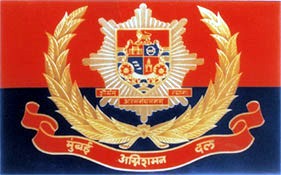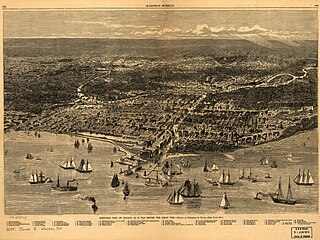
A fire department or fire brigade, also known as a fire company, fire authority, fire district, fire and rescue, or fire service in some areas, is an organization that provides fire prevention and fire suppression services as well as other rescue services.

The Bombay explosion occurred on 14 April 1944, in the Victoria Dock of Bombay, British India when the British freighter SS Fort Stikine caught fire and was destroyed in two giant blasts, scattering debris, sinking surrounding ships and setting fire to the area, killing around 800 to 1,300 people. Some 80,000 people were made homeless and 71 firemen lost their lives in the aftermath. The ship was carrying a mixed cargo of cotton bales, timber, oil, gold, and ammunition including around 1,400 tons of explosives with an additional 240 tons of torpedoes and weapons.

A boiling liquid expanding vapor explosion is an explosion caused by the rupture of a vessel containing a pressurized liquid that has reached a temperature above its boiling point. Because the boiling point of a liquid rises with pressure, the contents of the pressurized vessel can remain a liquid as long as the vessel is intact. If the vessel's integrity is compromised, the loss of pressure drops the boiling point, which can cause the liquid to convert to a gas expanding rapidly. If the gas is combustible, as in the case with hydrocarbons and alcohols, further damage can be caused by the ensuing fire.

A fireboat or fire-float is a specialized watercraft with pumps and nozzles designed for fighting shoreline and shipboard fires. The first fireboats, dating to the late 18th century, were tugboats, retrofitted with firefighting equipment. Older designs derived from tugboats and modern fireboats more closely resembling seafaring ships can both be found in service today. Some departments would give their multi-purpose craft the title of "fireboat" also.

Liverpool Salvage Corps was a service in Liverpool, England, founded and maintained by fire insurers, whose aim was to reduce the loss and damage caused by fires, to help mitigate the effects of fire and of fire-fighting and to salvage both premises and goods affected by fire. It was founded in 1842 and operated until April 1984, when its functions were transferred to the Merseyside Fire Brigade. Similar salvage corps also operated in London and Glasgow.

Fire insurance marks are metal plaques marked with the emblem of the insurance company which were affixed to the front of insured buildings as a guide to the insurance company's fire brigade. These identification marks were used in the eighteenth and nineteenth century in the days before municipal fire services were formed. The UK marks are called 'Fire insurance plaques'.

The London Salvage Corps was maintained by the fire offices of London. The corps was first formed in 1865 and began operations in March 1866. It was inspired by the Liverpool Salvage Corps which had been formed in 1842, to reduce the loss and damage caused by fires, to help mitigate the effects of fire and of fire-fighting and to salvage both premises and goods affected by fire.

The New York Fire Patrol (FPNY) was a salvage corps created by the New York Board of Fire Underwriters which operated from 1839 until October 15, 2006. Their original mission was two-fold: to discover fires and to prevent losses to insured properties. The Patrol responded primarily to fires at commercial structures, however they would respond to high loss residential fires at times. During the fire the Patrol would spread canvas salvage covers, remove water, operate elevators, and secure utilities. The New York Fire Patrol was organized under the International Association of Fire Fighters (IAFF) labor union as Local I-26.

The history of organized firefighting began in ancient Rome while under the rule of the first Roman Emperor Augustus. Prior to that, Ctesibius, a Greek citizen of Alexandria, developed the first fire pump in the third century BC, which was later improved upon in a design by Hero of Alexandria in the first century BC.

The Underwriter's Salvage Corps in Cincinnati, Ohio was created and operated by the Underwriters Association, a syndicate of Cincinnati-based fire insurance companies, for the purpose of reducing financial losses to their companies from claims due to building fires by providing a company of trained men with proper equipment to work in conjunction with the city fire department to protect life, structures and their contents from fire, smoke damage, and damage from the water that was used to fight the fire. The Salvage Corps worked to save and protect the structure and its contents while the city fire department concentrated on rescuing persons from the burning structure and extinguishing the flames. The Salvage Corps provided this service to all property owners without charge, whether they were insured or not.

The Mumbai Fire Brigade is the fire brigade serving the city of Mumbai, India. It is responsible for the provision of fire protection as well as responding to building collapses, drownings, gas leakage, oil spillage, road and rail accidents, bird and animal rescues, fallen trees and taking appropriate action during natural disasters.
The Cheapside Street whisky bond fire in Glasgow on 28 March 1960 was Britain's worst peacetime fire services disaster. The fire at a whisky bond killed 14 fire service and 5 salvage corps personnel. This fire was overshadowed only by a similar fire in James Watt Street on 19 November 1968, when 22 people died.
In September 1939, the British Army was in process of expanding their anti-aircraft and mobile assets. Among these new changes was the formation of Anti-Aircraft Command which was formed on 1 April 1939, and the 1st Armoured Division formed in 1937. The list below will include the British Army units, colonial units, and those units which were in the process of formation.

The 15th Cavalry Brigade was a brigade-sized formation that served alongside British Empire forces in the Sinai and Palestine Campaign, during World War I. Originally called the Imperial Service Cavalry Brigade it was formed from Imperial Service Troops provided by the Indian Princely States of Jodhpur, Hyderabad, Mysore, Patiala and Alwar which each provided a regiment of lancers. A maximum of three regiments served in the brigade at any one time. The states of Kashmir, Idar and Kathiawar provided smaller detachments for the brigade, which was at times reinforced by other British Empire regiments and artillery batteries when on operations.
The Kilbirnie Street fire, on Friday 25 August 1972, was a warehouse fire in the Port Eglinton area, on the south side of Glasgow, Scotland, which killed seven Glasgow Fire Service firemen in a flashover while they were trying to rescue a trapped colleague. What started as a routine industrial premises fire resulted in one of the highest losses of life for the UK Fire Service at a single incident in peacetime.

The Chicago Fire of 1874 took place on July 14. Reports of the extent of the damage vary somewhat, but sources generally agree that the fire burned 47 acres (19 ha) just south of the Loop, destroyed 812 structures and killed 20 people. The affected neighborhood had been home to Chicago's community of Jewish immigrants from Russia and Poland, as well as to a significant population of middle-class African-American families; both ethnic groups were displaced in the aftermath of the fire to other neighborhoods on the city's West and South Sides.
The 1873 Birthday Honours were appointments by Queen Victoria to various orders and honours to reward and highlight good works by citizens of the British Empire. The appointments were made to celebrate the official birthday of the Queen, and were published in The London Gazette on 24 May 1873.
Glasgow Fire Service provided emergency services such as fire prevention, firefighting, emergency medical services and technical rescue to Glasgow, the largest city in Scotland and the third-largest city in the United Kingdom. On 16 May 1975, the Glasgow Fire Service was absorbed into the now defunct Strathclyde Fire and Rescue Service.

On 9 July 1872 the Tradeston Flour Mills, in Glasgow, Scotland, exploded. Eighteen people died, and at least sixteen were injured. An investigation suggested that the explosion was caused by the grain feed to a pair of millstones stopping, causing them to rub against each other, resulting in a spark or fire igniting the grain dust in the air. That fire was then drawn by a fan into an "exhaust box" designed to collect grain dust, which then ignited, causing a second explosion which destroyed the building. At the time, there were general concerns about similar incidents worldwide, so the incident and investigation were widely reported across the world.

Glasgow Salvage Corps was a service in Glasgow, Scotland. It was founded after local fire insurance companies were concerned over losses in serious fires. They inspected buildings for fire safety, increasing premiums if any of their recommendations were not met, and attended fires alongside the Fire Brigade. It was founded in November 1873 and operated until 1 April 1984, when its functions were transferred to the Glasgow Fire Service. Similar salvage corps also operated in London and Liverpool.
















